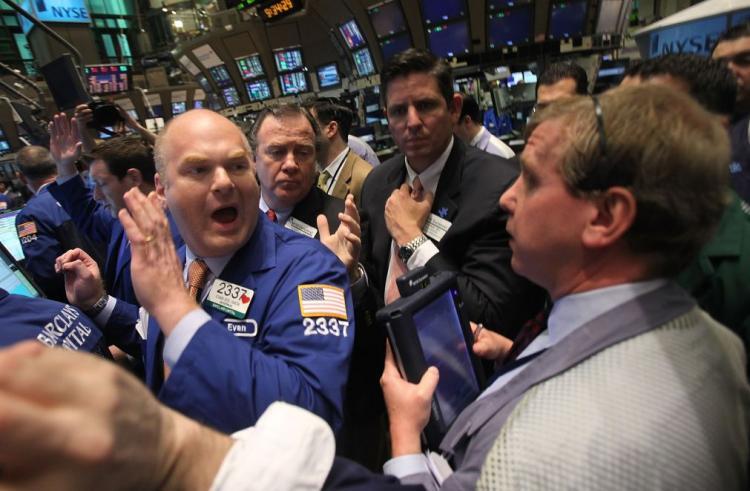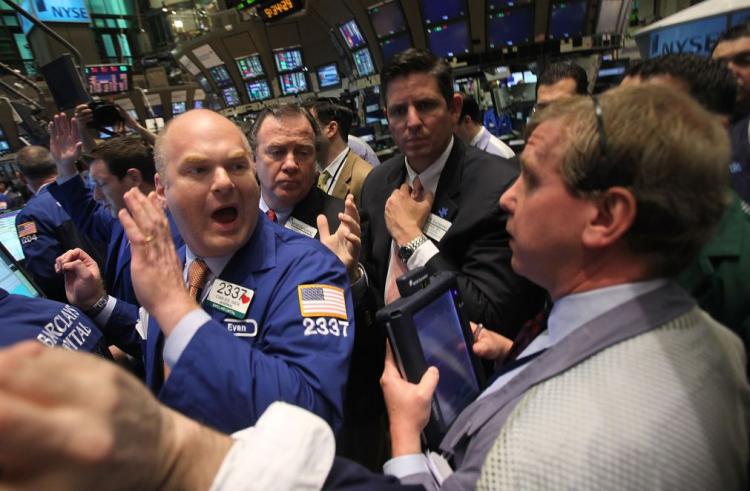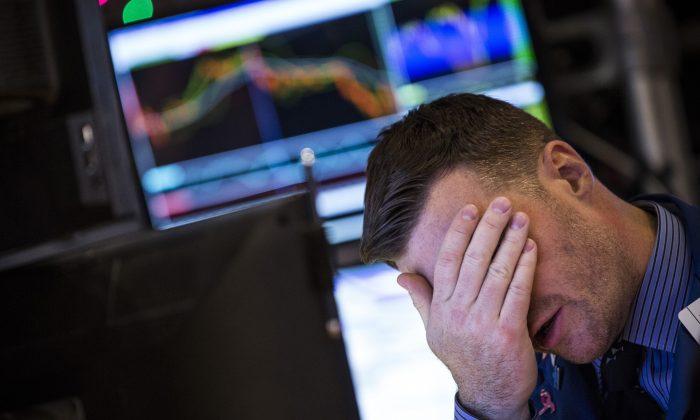NEW YORK—In a somewhat ironic moment, Proctor & Gamble Co. executives smiled as they ran the closing bell at the New York Stock Exchange (NYSE) last Friday, a day after the company’s shares tumbled almost 40 percent momentarily due to a rumored glitch.
Shares of Cincinnati-based consumer products producer Proctor & Gamble (P&G), a blue-chip component of the Dow Jones Industrial Average, mysteriously dropped from $62 to below $40 in midafternoon Thursday, amid an overall market drop of close of 1,000 points on the Dow. In addition to P&G, several other prominent stocks—including that of 3M Co. and Accenture Ltd.—saw gigantic temporary declines.
Currently, the U.S. Securities and Exchange Commission and Commodities Futures Trading Commission are investigations what caused the market changes on Thursday.
So far, no reason has been identified publicly but several experts believe that computer or algorithmic trading programs exacerbated the market gyrations last Thursday.
Reports indicate that there were one or several erroneous trade inputs from traders that caused the initial fall. But algorithmic trading platforms helped to worsen the fall by selling massive positions without human input.
Computer programs are designed with complex mathematical and algorithmic formulas to trigger buy or sell orders without human input as the price shift of certain stocks triggers such a trade. One reason for inventing such platforms is that they trade much faster than a human being possibly can, to take advantage of certain price changes and movements in stock price.
However, during the 20-30 minutes that the market went haywire last Thursday, while NYSE stopped trading, other exchanges such as Direct Edge or Nasdaq continued to update prices and gained in volume—causing a fragmentation in the market. Under the national market exchange system, NYSE only controls one-fifth of actual trading volume of the stocks listed on the NYSE.
“Our market oversight units are reviewing trading and market data from the exchanges, self-regulatory organizations, and market participants to examine yesterday’s unusual trading activity,” said the SEC in a statement. “We are scrutinizing the extent to which disparate trading conventions and rules across various markets may have contributed to the spike in volatility.”
Experts say that a lack of a market-wide circuit breaker contributed to the market haywire last week.
CEO William O’Brien of Direct Edge, the newest stock exchange in the United States, told Reuters, “The systems should have been closed down for a period of time, market-wide.”
In total, $1 trillion in market value was erased last Thursday.
Solid corporate earnings buoyed the markets over the last several weeks but concerns over European countries’ debt sent markets tumbling last week. Oil, another indicator of market strength, experienced last week the biggest drop in two years.
The Stoxx Europe 600 Index, a broad-based European stock index, fell 3.9 person on Friday, after a 110 billion-euro (US$140 billion) rescue loan for Greece failed to impress, sending borrowing costs of several other European nations higher.
“After the global financial crisis, it’s not irrational for investors to shoot first and ask questions later. We need the ECB [European Central Bank] to come out decisively and put a stop to this before things spin out of control,” said Prasad Patkar of Platypus Asset Management Ltd. in a Bloomberg interview.
“Nerves are frayed,” Patkar said.
Shares of Cincinnati-based consumer products producer Proctor & Gamble (P&G), a blue-chip component of the Dow Jones Industrial Average, mysteriously dropped from $62 to below $40 in midafternoon Thursday, amid an overall market drop of close of 1,000 points on the Dow. In addition to P&G, several other prominent stocks—including that of 3M Co. and Accenture Ltd.—saw gigantic temporary declines.
Currently, the U.S. Securities and Exchange Commission and Commodities Futures Trading Commission are investigations what caused the market changes on Thursday.
So far, no reason has been identified publicly but several experts believe that computer or algorithmic trading programs exacerbated the market gyrations last Thursday.
Reports indicate that there were one or several erroneous trade inputs from traders that caused the initial fall. But algorithmic trading platforms helped to worsen the fall by selling massive positions without human input.
Computer programs are designed with complex mathematical and algorithmic formulas to trigger buy or sell orders without human input as the price shift of certain stocks triggers such a trade. One reason for inventing such platforms is that they trade much faster than a human being possibly can, to take advantage of certain price changes and movements in stock price.
Exchange Fragmentation
What further contributed to the volatility was a fragmentation in stock exchanges. The NYSE has circuit breakers that halt trading when whole market declines as well as individual stock declines reach a certain threshold.However, during the 20-30 minutes that the market went haywire last Thursday, while NYSE stopped trading, other exchanges such as Direct Edge or Nasdaq continued to update prices and gained in volume—causing a fragmentation in the market. Under the national market exchange system, NYSE only controls one-fifth of actual trading volume of the stocks listed on the NYSE.
“Our market oversight units are reviewing trading and market data from the exchanges, self-regulatory organizations, and market participants to examine yesterday’s unusual trading activity,” said the SEC in a statement. “We are scrutinizing the extent to which disparate trading conventions and rules across various markets may have contributed to the spike in volatility.”
Experts say that a lack of a market-wide circuit breaker contributed to the market haywire last week.
CEO William O’Brien of Direct Edge, the newest stock exchange in the United States, told Reuters, “The systems should have been closed down for a period of time, market-wide.”
In total, $1 trillion in market value was erased last Thursday.
Stocks Decline Again on Friday
On Friday, there were no sudden market gyrations, but overall the markets disappointed again. The Dow Jones Industrial Average shed 140 points, or 1.3 percent, and at one point was down 350 points. Other indices posted similar declines.Solid corporate earnings buoyed the markets over the last several weeks but concerns over European countries’ debt sent markets tumbling last week. Oil, another indicator of market strength, experienced last week the biggest drop in two years.
The Stoxx Europe 600 Index, a broad-based European stock index, fell 3.9 person on Friday, after a 110 billion-euro (US$140 billion) rescue loan for Greece failed to impress, sending borrowing costs of several other European nations higher.
“After the global financial crisis, it’s not irrational for investors to shoot first and ask questions later. We need the ECB [European Central Bank] to come out decisively and put a stop to this before things spin out of control,” said Prasad Patkar of Platypus Asset Management Ltd. in a Bloomberg interview.
“Nerves are frayed,” Patkar said.





